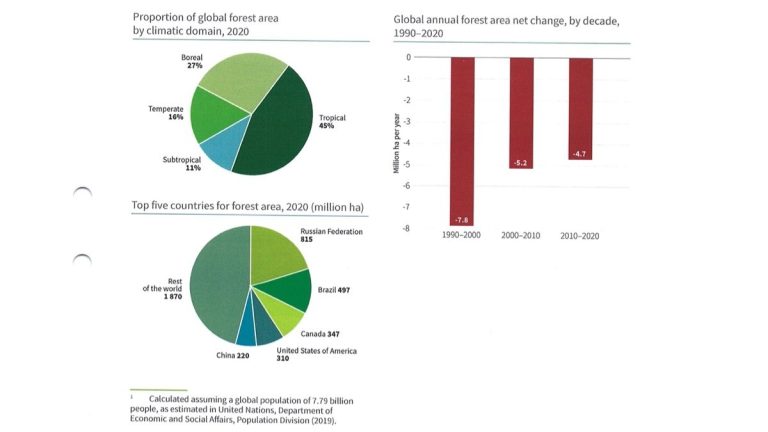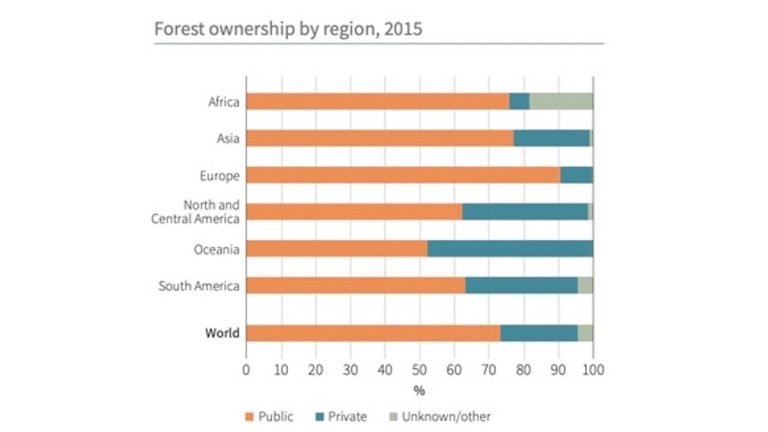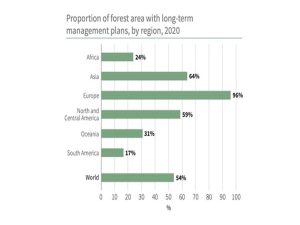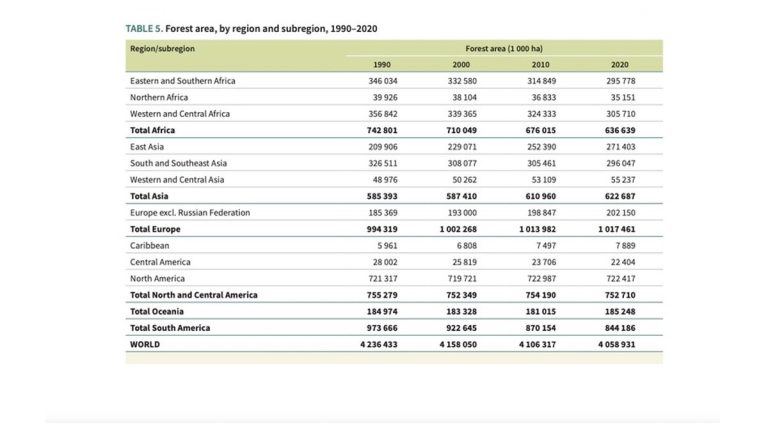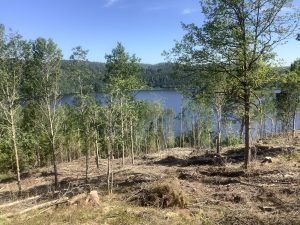If you really like to spend time in the forest you should move to Surinam on the northeast coast of south America. Why? Because 97 % of that country is covered with forest. If you don´t like the forest (you probably don´t read NordicWoodJournal.com) you can move to the Falkland Islands, Monaco, Gibraltar, Svalbard, or Qatar as they have no forest at all.
The forests of the World
The FAO report “Global Forest Resources Assessments 2020: Main report, Rome” presents facts and figures about the World’s forests. Where the forests are and in what shape they are. The report is almost 170 pages long so, you can either read it all during your summer vacation, or you can see the most important figures in this article – according to me.
Basics
The total forest area of the World according to the report is 4,06 billion hectares (ha). That is 31 % of the total land area of the World. 45 % of the 4,06 billion ha is tropical forest, 27 % is boreal forest, 16 % is temperate and 11 % is subtropical forest.
More than half the forest land (54 %) is located within five countries: Russia, Brazil, Canada, USA and China.
Source: FAO. 2020. Global Forest Resources Assessment 2020: Main report. Rome.
The forest area is decreasing, but the good news is that the rate of loss has slowed down. Since 1990 we have a net loss of 178 million ha of forest land. Between 1990 – 2000 the loss was 7,8 million ha per year. Between 2000 – 2010 it was 5,2 million ha and 2010 – 2020 it was 4,7 million ha. The rate of decline in last decade is explained in the report by a reduction in the rate of forest expansion.
Limited need for planting(?)
When you have worked in the forest as long as I have, 40 years and some more, you think you have a fairly good picture of the situation. Little did I know about e.g., natural regeneration. As little as 7 % the World’s forests is planted, the rest is reforested by itself. Globally, about 3 % of the forest land is pure plantation forest (45 % of the total planted area). In south America alone, 99 % of the planted forest is plantation forest. In Europe, only 6 % of the planted forest is in plantations.
The species in the plantations varies between regions. In central and north America, the plantations contain mainly native species. In south America, the plantations are almost only introduced species.
As being a former salesman for planting heads I see a huge potential here as the area of planted forest is increasing.
Who owns the World’s forests?
The share of private ownership has increases since 1990, but 73 % is still public owned forest land. 22 % is private owned and the rest is “unknown” or “other” due to disputes and other causes.
At least 1,11 billion hectares of the World’s forests are primary forests – that is they are composed of native species and there are no clear signs of human activity or disturbance of the ecological processes. Brazil, Canada and Russia together, holds 61 % of the primary forests of the World. The primary forests have decreased by 81 million ha since 1990, but the rate of loss more than halved in 2010 – 2020 compared to previous decade.
Most of the forests in Europe have management plans. On the other hand, those plans are unusual in other parts of the World. I Africa, less than 25 % of the forest land have a management plan. In south America less than 20 %. However, the area of forests under management plan is increasing everywhere, and in 2020, 2,05 billion ha are under some kind management plans (I guess types of plans differs between regions).
That´s some 50 % of the total forest land Worldwide, which is strange for a forester/logger, as only about 30 % of the total forest area is used for production.
What about growth?
Do the World’s forests grow or are they disappearing? The public in many countries shows more and more interest and engagement in our forests. A common point of view is that the forests are disappearing and that we must stop cutting them. As I pointed out in a previous article, not all see the connection between their own lifestyle and the need to cut down trees. But how does it actually look?
From 1990 to 2020 the growing stock was decreased from 560 billion m3 to 557 billion m3 in 2020. This is mainly due to the decreasing forest area. On the other hand, the stock per unit was increasing from 132 m3per ha in 1990 to 137 m3 per ha in 2020.
About 10 % of the global forest land is allocated for biodiversity conservation. That is what we like to call protected forests. What a protected forest is, is much discussed and I also wrote about it here at NordicWoodJournal.com.
In total, the area of forest land is decreasing, and it´s mainly the African continent that is pulling the figures down. When looking at the other continents it doesn´t look too bad. In Asia and Europe, the forest area is increasing. North and Central America, and Oceania have a quite steady area of forest land. In south America it´s decreasing.
Source: FAO. 2020. Global Forest Resources Assessment 2020: Main report. Rome.
Summary
It can´t be easy to bring all the World’s forests together in one report, not even on 170 pages. We are talking about 4,06 billion hectares(!!) in over 200 countries. Over 700 people were involved in the process of making the report and it took five years. So, it´s an overview, probably the only one there is. Well, if anyone feels that he or she can make it better – go ahead, and let me know when it´s finished.
It seems that we will have forests to manage for a long time still, maybe forever. But taking it for granted could be dangerous. That´s why it´s good that FAO makes reports like this occasionally. Otherwise, it wouldn´t be possible to know what´s going on in the World’s forests. We tend to be satisfied just knowing what´s going on close to ourselves and avoid learning about other places and problems.
I would say that there is hope for the future, but we can´t fall asleep. We have to watch out for both illegal logging and environmentalists. Most of all, if you ask me, we must make sure to get the proper information about what we are doing and why, out to the public. That´s a challenge!
Photo: Per Jonsson
Sources: FAO. 2020. Global Forest Resources Assessment 2020: Main report. Rome. Wikipedia.






